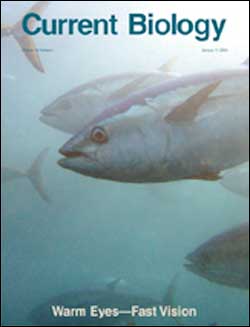Predator fish heat their eyes to track prey

Large and powerful predators such as swordfishes, tunas, and many sharks are unique among fishes in that they possess physiological mechanisms that warm their eyes. A new investigation reported this week sheds important light on the purpose of warming the eyes and the advantage that “warm eyes” confer on ocean predators.
Swordfishes, which hunt in water as cold as 3°C (about 37°F), can maintain their brain and eye temperatures 10°C–15°C (18°F –27°F) above ambient temperatures by using a specially adapted heating organ in muscle next to their eyes. The biological significance of this has been a mystery. Now, however, innovative research has shown that warm eyes allow swordfishes to process visual information more than 10 times more quickly than eyes cooled to the temperatures of deep-water environments.
Ship-board experiments by Kerstin Fritsches of the University of Queensland, Richard Brill of the National Marine Fisheries Service, and Eric Warrant of the University of Lund focused on electroretinogram recordings of freshly caught swordfishes. These established that higher eye temperatures maintain the speed of the retina’s response to stimuli. Using temperatures and light intensities aligned with swordfishes’ dive profiles, the team showed that by heating their eyes, swordfishes retain the ability to spot quickly moving objects, allowing them to intercept rapid and elusive prey.
These findings offer a fascinating view into how an evolutionary “arms race” has led to a sensory specialization that gives a predator a significant edge over its prey.
Media Contact
All latest news from the category: Life Sciences and Chemistry
Articles and reports from the Life Sciences and chemistry area deal with applied and basic research into modern biology, chemistry and human medicine.
Valuable information can be found on a range of life sciences fields including bacteriology, biochemistry, bionics, bioinformatics, biophysics, biotechnology, genetics, geobotany, human biology, marine biology, microbiology, molecular biology, cellular biology, zoology, bioinorganic chemistry, microchemistry and environmental chemistry.
Newest articles

A universal framework for spatial biology
SpatialData is a freely accessible tool to unify and integrate data from different omics technologies accounting for spatial information, which can provide holistic insights into health and disease. Biological processes…

How complex biological processes arise
A $20 million grant from the U.S. National Science Foundation (NSF) will support the establishment and operation of the National Synthesis Center for Emergence in the Molecular and Cellular Sciences (NCEMS) at…

Airborne single-photon lidar system achieves high-resolution 3D imaging
Compact, low-power system opens doors for photon-efficient drone and satellite-based environmental monitoring and mapping. Researchers have developed a compact and lightweight single-photon airborne lidar system that can acquire high-resolution 3D…





















